After a quick overview of the positions on the soccer field and the player numbering system, we’ll take a deeper dive into the roles.
Each role description explains the responsibilities of a soccer coach’s take on the position with insights into the role.
How Many Players on a Soccer Team?
There are 11 players on a soccer team when played at a high school, college, or professional level.
These are the standard positions:
Goalie: The Goalkeeper.
Defense: Sweeper, Left Defender, Right Defender, Stopper.
Midfielders: Left Midfielder, Center Midfielder, and Right Midfielder.
Offense: Left Striker, Center Forward, and Right Striker.
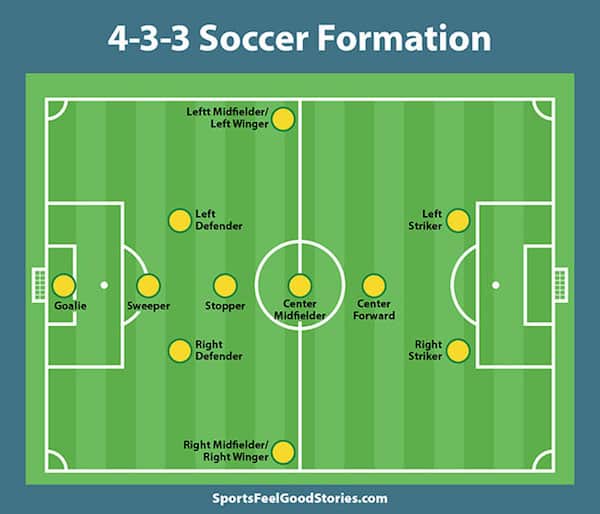
Younger Leagues
For younger leagues – think ages 10 and under – it’s common for rules to feature only 6 players on a youth team, including a goalie. While for ages 10 – 14, you may find leagues that play with 8 players, including the goalie.
For purposes of this article, we’re going to focus on the higher level of play and 11 players per team. If you were to be asked how many players are on a soccer field? The answer would be 22. Take 11 players on each team; times two equals 22.
You might like our Soccer Captions page.
What Are Soccer Positions Numbers?
The soccer numbering system started in the 1920s to identify players quickly – especially on diagrams. A number is assigned to each player. A similar numbering system works for baseball positions.
The soccer number system works defined like so:
Goalie or Goalkeeper.
Right Defender or Right Fullback.
Left Defender or Left Fullback.
Stopper or Center Back.
Sweeper or Center Back.
Left Midfielder.
Right Midfielder.
Center Midfielder.
Right Striker.
Center Forward or Attacking Midfielder.
Left Striker.
Ok, let’s take a deeper dive into each soccer or futbol position.
You might like Soccer Field Dimensions.
Soccer Positions Explained
A soccer team, not unlike an orchestra, functions most effectively when all its parts know their roles and perform at the highest level. Let’s take a closer look at the roles and responsibilities of the various soccer positions.
See Best Premier League Chants.
Defense
Most defenses will be a goalie and four players, two centers, and two wide. Some defenses can have as few as three players (plus the goalie), while others can be stacked with five.
Goalie
There is only one Goalie, and it is the loneliest position in soccer. The goal of the goalie is to prevent the other team from scoring. For most of the game, the goalie stands by the net within the penalty area, watching, but at any moment might be called into action. When those moments arise, the goalie cannot hesitate.
The goalie must instantly decide how to bark orders to the sweeper and the rest of the defense based on the threat as it develops down the field. Goalies can see the whole field while the other players often cannot, so the goalie must be the loudest player and constantly communicate with the rest of the team.
The goalie must decide how to block a shot based on instincts and intuition alone in some situations. Subtle cues can telegraph an opponent’s next move, and the Goalie must learn the tells and act accordingly.
You might like our position descriptions for other sports at fan guides.
Coach’s Take on the Goalie Role
The goalie is a different breed of a soccer player. Different uniforms, different practice schedules, different rules. The goalie must be agile yet big, strong, and smart. Must possess a strong leg and have a precision touch.
Good hand-eye coordination is an absolute necessity. And beyond these things, the goalie must be tough and durable because of the diving and collisions that are just part of the game for the Goaltender. A goalkeeper’s strong punting and kicking skills can put teammates in a good position to succeed.
Goalkeepers Role
This is arguably the most important decision a coach can make when deciding whether a player should be a goaltender. The skillsets for goalie do not transfer well to the skill sets for the other positions and vice versa. It is one of the most challenging soccer positions to play.
A good goalie can help a team reach its potential; it can make the team almost unbeatable. Or, make a poor team into a good team single-handedly. It is very uncommon for a competitive team to switch goaltenders during a game.
Sweeper
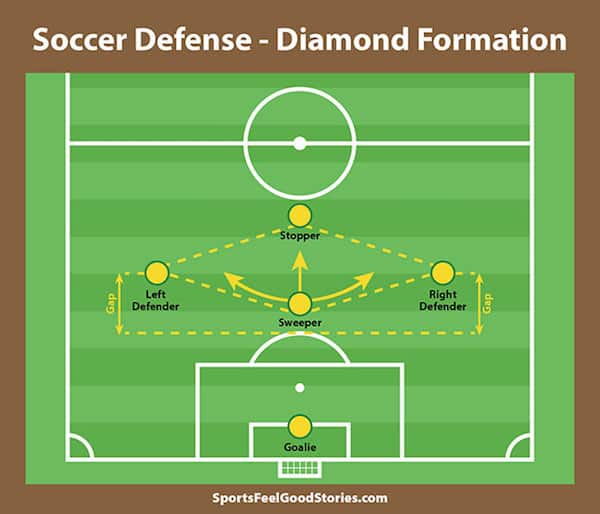
The last line of defense and often the best player on the defense. The sweeper should be one of the most talented players on the field overall and must be confident, decisive, and commanding.
This position must always be aware of the other players and where they are and analyze the threats. The sweeper does not need to be an endurance runner but does need to be quick. Inevitably, there will be foot races to the goal, and if the sweeper gets beat, then the opponent is on a breakaway.
Coach’s Take
A leader in the back. The sweeper should have exceptional ball control, fast, strong leg, and give orders to the other defenders and midfield. The sweeper often can see the whole field and should make adjustments for the defense as they are needed. Sweepers and goalies must have good communication.
Word to the Wise on Sweepers
Most diagrams will show the sweeper in a diamond formation. However, the sweeper should not play in a diamond formation because this allows the opposing players to drop behind the Right and Left defenders without being offsides.
Check out 73 Inspirational Ted Lasso Quotes.
Right/Left Defenders

The substance of the defense. This defensive position doesn’t need to be independently flashy but must be filled by a solid player. Must be able to move all the way to the sideline and the center of the field.
The R/L Defenders don’t want to be positioned out too wide but should be somewhere halfway between the out-of-bounds lines and the middle of the field (width). If the R/L defenders are too center or are flared out too wide, they create too much space for the opposing offense to move into. Must be quick to engage the opposing players because the sweeper, stopper, and midfield will assist.
Coach’s Take
The defense is a system. No one player is bigger than the defense. Although it is always nice to have players with a history of playing together, it is more important to have players that can learn the system and play as a unit. Right, and left defenders need to be a part of the unit above being individual playmakers.
Word to the Wise on Defenders
If there is a player that is heavily (for example) right foot dominant, the Right Defender position is a place where that can be masked (but the Left Defender position could expose this).
Stopper
In some ways, you could describe the Stopper as a defensive-minded midfielder. Although all players on the field can defend, the stopper or central defender is truly the first line of defense. The stopper can assist the left and right defenders and midfielders.
This stopper position meets any balls that break through the midfield and send them back upfield. The stopper acts as a safety net and a reset option for the midfielders. If they run into trouble, they can pass the ball back to the stopper rather than turn it over. The stopper then advances the ball back to the midfielders.
Coach’s Take
The stopper doesn’t need to be the most athletic player, but a strong leg and the ability to engage the opposition directly will make for a good fit.
Word to the Wise on Stoppers
The defense is a unit, but a stopper position is a good place for a player that also has individual skills because it is a position that will allow the player to showcase and utilize those talents.
Midfield
Some teams will run a 4-2-4: four defense, two midfield, four offense. Other teams will run a 4-5-1. It depends on the coach’s preference, the talents of the team, and the strengths of the opponent.
Although the midfield is removed from the goals, most of the action on the field is played out in the midfield. A strong midfield presence will often result in more possession time for a team.
You might like Cristiano Ronaldo Quotes and FAQs.
Center Midfield
The center mid, or central midfielder, needs to play well with all players. The jack of all trades: can push up to be offense and score and assist a goal, is the centerpiece of the midfield, and drops back to help the defense.
The Center mid should have great ball control and must be one of the best passers on the team. Chances are the center mid will find themselves around the ball more than any other player on the field. This means they will have ample touches, so quality is a huge advantage.
Coach’s Take
The player that plays well with all the other players. Because of the high volume of touches, you want a player that doesn’t make a lot of mistakes when they have the ball at their feet. This is a great place for a player with a lot of well-rounded talents and good athleticism. Size is secondary to these qualities.
Word to the Wise
If the center-mid is having a bad day, the entire flow of the team might be off as a result.
Right & Left Midfield / Winger
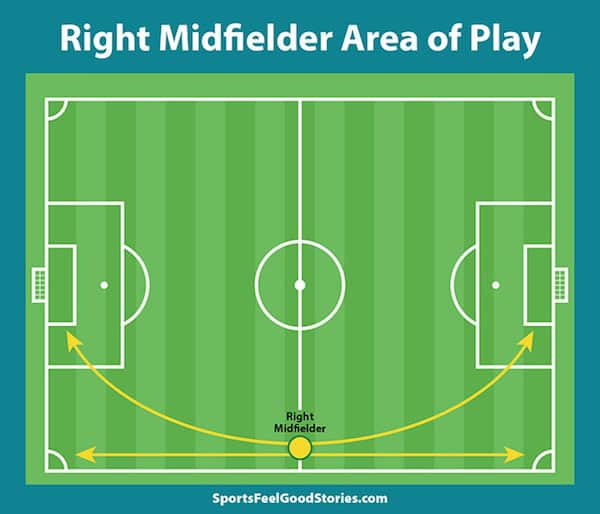
The right and left midfield – or wide midfield positions – are side supports for every position on the field. Sometimes these outside midfielders are asked to go post-to-post which means they attack the opposing net, drop in for headers by the goal, and defend the back-post of their own net against headers or opposing players sneaking in behind the goalie.
A winger is essentially the same thing as an outside mid, but with a real emphasis on playing out wide. The R/L wingers want to stay outside to create as much space as possible. Wingers also tend to focus on sending long crosses into the box when attacking.
Coach’s Take
Your endurance athletes and long-distance runners. The ability to stay in position is key; if the R/L midfielders get too exhausted, the support isn’t there for the other players. If a player is right or left-foot dominant, this can be masked by placing them on that side of the field.
Word to the Wise on Midfielders
Conditioning is the most important part of the right/ left midfielder’s game. It is not uncommon for an outside midfielder to run 5-8 miles during a 90-minute game.
Offense
If the offense can’t put points on the board, it doesn’t matter how good a team’s goalie, defense, and midfield are. Scoring goals is the most celebrated part of soccer for a reason: scoring goals wins the game.
Some teams that favor possession might play with only one striker with a heavy, systematic midfield as support. Other teams might play with four players on offense, especially if scoring multiple goals is required to win the game.
Center Forward
The center forward needs to be able to win and possess balls. With this position, skills should include a good balance of strong and technical, keeping the ball away from the defenders. While at the same time, the player should be thinking of advancing the ball or biding time for the midfielders to get moved up the field.
Coach’s Take
The center forward has every right to score, but the longer they possess the ball, the more of a distraction they become for the opposing team. This can help give the strikers a chance to work into space or behind the defense, which gives them a good score.
Word to the Wise
The center forward should be a mix of everything, although bigger size and strength are favorable because it is important for the center forward to win headers. Lionel Messi is an example of a high-performing forward.
Strikers
(In this layout, the 10th and 11th players are both strikers). Some teams will have only 1 striker. Strikers do not need to have endurance, but they do need to have quickness and “breakaway” speed. Even if the striker is only one step faster than the defender, that is enough to get a clean shot at the net.
Strikers should be ambidextrous with their feet and have a blend of power and finesse in their shots. Strikers should be trigger-happy but accurate. Shots on goal are a good thing; getting the perfect shot isn’t always good because it gives the goalie and defense the split seconds they need to get into position. (A quick, decent shot with the left foot is better than taking the time to get a “better” shot with the right foot).
Strikers need to “crash the box.” They should be in a position if the goalie stops a shot but can’t corral it; a high ball perfect for a header in front of the net; getting a leg in on a crossing shot to deflect it away from the goalie and into the net. Strikers also need to be ready to counter-attack with blazing speed.
Coach’s Take
Who are your most dangerous players? You want players with a finishing instinct that has the ability to strike and score any time they have the ball. Aside from possibly the sweeper, having the most talented players at striker or forward is never a bad idea.
The game’s name is score points – even if the quantity of touches is lower for your strikers than other players. The quality is what matters. One goal can – and often does – decide the game. Finding players who have the ability to create offense should be the goal of soccer coaches in every practice.
Word to the Wise
Offenses that play together stay together. If players have a history together and have a “feel” for one another, it is always a good idea to keep that chemistry on the field. When it comes to offense, chemistry can be more important than employing a strict system and asking players to change their game to fit the system.
Soccer Formations
For soccer formation numbers, pretend your team’s goalie is on the left side. The first number refers to the number of defenders. The second number refers to midfielders. And lastly, the third number refers to offensive players.
So, by way of example, a 4-5-1 formation includes 4 defenders, 5 midfielders, and one offensive player. Coaches use different formations based on the strengths and weaknesses of their team, the make-up of the opposing team, and the stage and score of the game.
Regarding the latter point, a team that might typically play a 4-5-1 formation might switch to a 4-3-3 formation if they’re behind by two goals in the second half.
4-5-1 Formation
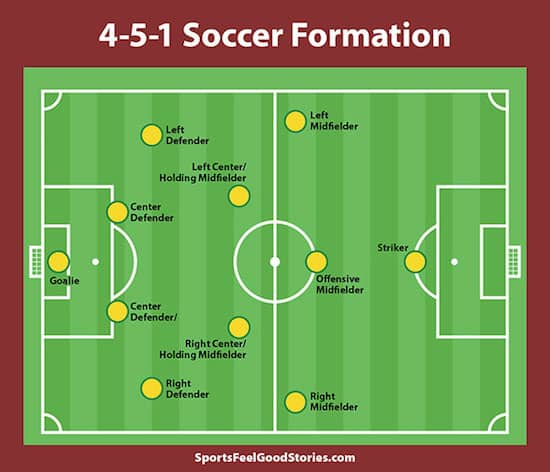
A conservative approach to aligning your players for competition. Yet, it can still be wildly effective. A coach might use this type of formation to play to their team’s strengths or to shut down a high-potent offense. On attack, this formation might turn into a 4-3-3 alignment quickly.
This approach places a heavy burden on the sole striker to threaten the opposition with scoring opportunities.
4-3-3 Soccer Formation
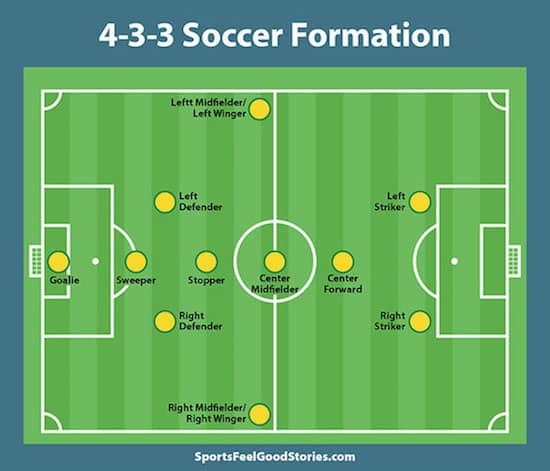
Teams with a winning attitude seem to employ a 4-3-3 formation with considerable success. When in attack mode, this alignment enables 7 players to be in a position to create offense and score goals.
The 4-3-3 is great for creating passing triangles and enabling three strikers to get very close to the goal.
On the downside, this formation can be vulnerable to counter-attacks. And, if an offensive team has difficulty maintaining possession, the squad can be burned easily.
4-2-4 Formation
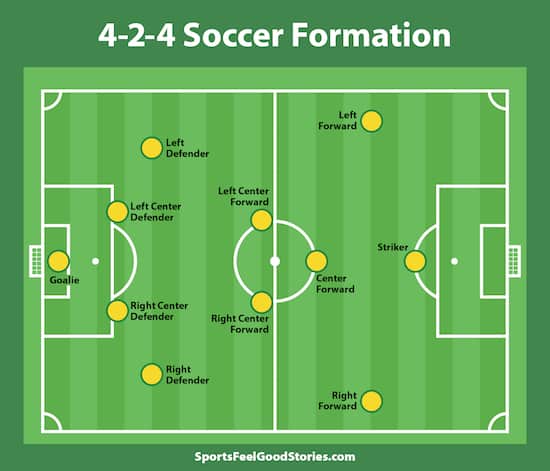
With four offensive players in the 4-2-4 formation, a team employing it might be advantageous because strikers are left unchecked. As part of the objective, let most of the play occur on the offensive side of the field.
If a coach chooses this option, they’ll have to rely on two powerful midfielders to make it work.
Asymmetrical Formations
The previous formation is balanced. However, as a one-off of these formations, a coach may try to leverage a team’s strength at one position or an opponent’s weakness by aligning players in a “loaded” fashion.
If the opposition has a weak left defender, the coach might overload the right side to take advantage of this. Soccer positions can be changed to suit the situation.
With all formations, there are lots of variations that a team can choose. It’s important to be aware of what formation the other team uses and make your team’s formation selection accordingly.
Summary
As you can see from the roles, responsibilities, and formations, soccer can get complicated. There are many strategies and tactics to consider for what seems to be a rather simple game of kicking a ball into a net when assigning players to roles and selecting the best formation for your team.
The beautiful game is worthy of study. Have fun diving in deep.
By Evan Wolf
Evan, a former college soccer player, still plays recreational soccer while also finding time to practice judo and running.
Overtime
You’re on Soccer Positions: Roles, Responsibilities, Formations page.
You might like:
